|
January 13, 2002
Winter Tree ID & Winter Tracking
(Photos and report by Walter Muma) |
|
|
Nine people gathered at a wilderness area west of Toronto
for a day of exploring, tree identification, and tracking. As well as
investigating anything else that we happened upon in the Natural world. We
set out at 10am, and stayed out until dark (5:30pm). Such was the allure
of the natural world, we only traveled about 2 km in that time.
A big welcome to newcomers Bev, Alex, Alexis, Bob, and Kyle!
Here in these two pages is just a sampling of what we
discovered along the way.
|
|
|
|
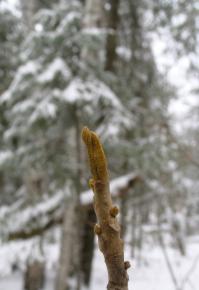
|
This baby tree/shrub
"stumped" us. The closest we could come to identifying it
in the field was witch hazel! However, research at home verified that it was a
young bitternut
tree (sapling).
Other trees and shrubs we identified were: hop
hornbeam, blue beech, American beech, rock elm, black and white ash,
sugar maple, butternut, white and yellow birch, prickly ash,
alternate-leaved and red osier dogwood, Scots, white, and red pine,
white and Norway spruce, cedar, aspen, rock elm, poison ivy, red
elderberry, honey locust, and more.
This is actually a picture from another, later
walk. The picture from this meeting didn't turn out.
|
|
| |
|
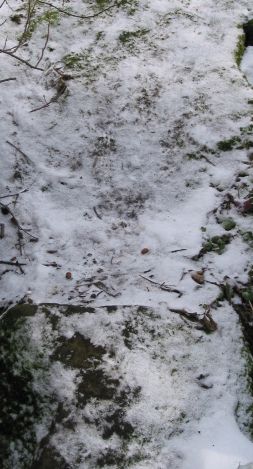
|
Tracking wasn't as big a
part of the day as we had hoped. A week of thawing snow had made
most tracks into blobs, as well as rendering some areas snowless. So
there were not a lot of fresh tracks. But we made the most of the
ones we found!
However, we found some very good porcupine tracks,
and we spent some time investigating them, in two separate areas.
Here is one porcupine's tracks leading up a rock
from its den. The claw marks are readily visible in the snow.
|
|
|
|
|
|
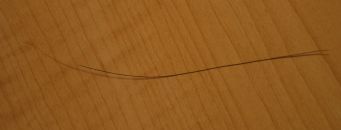 |
At the above location
where the claw marks are, we found a couple of hairs.
Here is a picture of one taken later on, at home.
|
|
| |
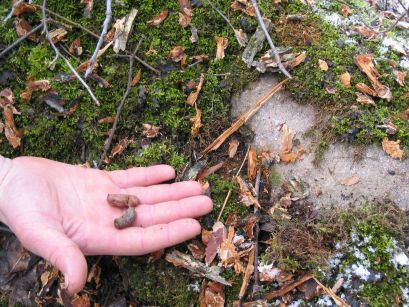 |
Nearby we found plenty of
porcupine scat. Here we see it mixed in with bark fragments from a
tree that the porcupine had been gnawing on.
|
|
|
|
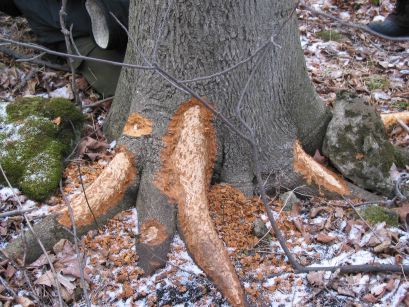 |
These gnawings were made
by a porcupine who evidently saw no need to actually climb the tree!
It is rare to see this - most of the time porcupines like to be up
in a tree to eat.
Note the bark chips piled up at the base of the
tree.
|
|
| |
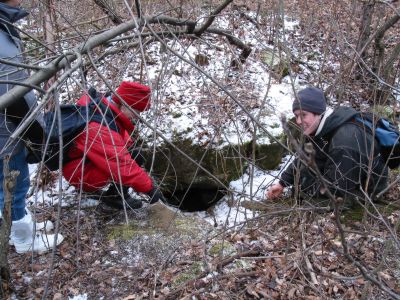 |
Investigating the den
entrance of one of the porcupines.
|
|
|
|
|
During the day we also found tracks made by grey squirrel,
raccoon, deer, coyote, and rabbit/hare.
|
|
|
 |
The woods we explored was a mostly deciduous
forest, with some areas of cedar swamp and marsh. There
were a lot of rocky areas, which give shelter to small animals. |
|
| |
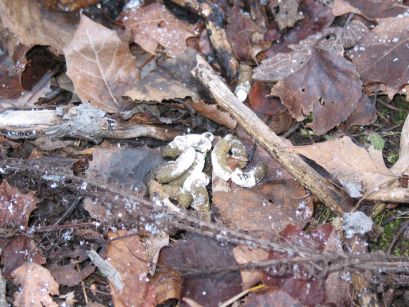 |
Ruffed Grouse scat.
(For more info on scat,
please visit the
Wildwood Tracking website).
|
|
|
|
 |
Our progress through the
woods was extremely slow as we stopped constantly to investigate
natural things that we found: plants, tracks, saplings, moss, trees,
etc etc.
Here the group has found hepaticas peeking through
the snow (see picture below).
|
|
| |
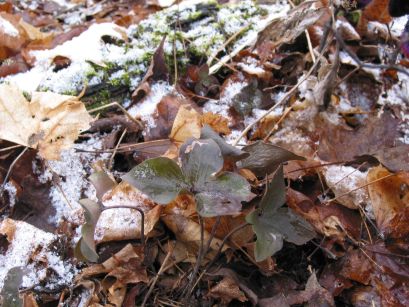 |
The beautiful evergreen
leaves of hepatica peeking through the snow, hinting at the faraway
promise of spring. Hepaticas are among the very first flowers to
bloom in the spring. |
|
|
|
 |
Towards sunset we came
upon a swift-flowing clear woods stream with water cress growing
under the surface.
|
|
| |
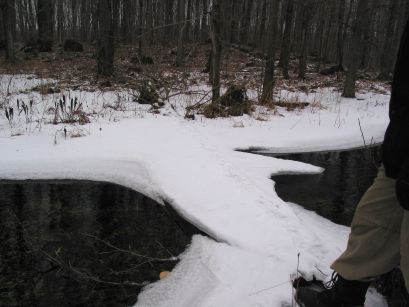 |
A fallen tree has provided
this bridge for raccoons and other animals. |
|
|
|
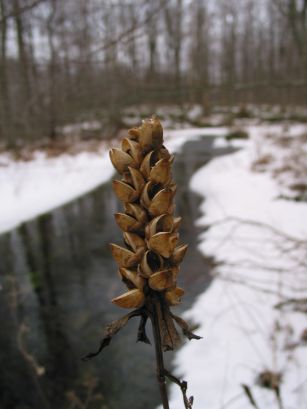 |
Here is this month's
mystery plant.
This seed head was on a non-woody stalk right by
the stream.
Thanks to Tim Martens and Peter
Moc for identifying this plant for us!!
It's a turtlehead.
|
|
| |
| For more Tree ID information, visit the
Ontario Trees website. |
|
|
| |